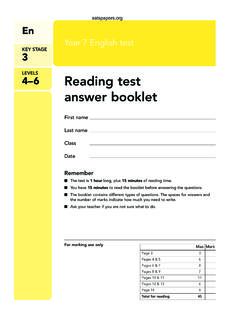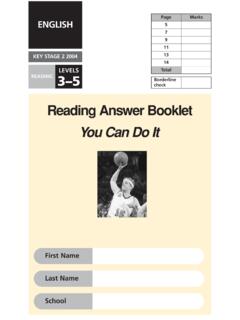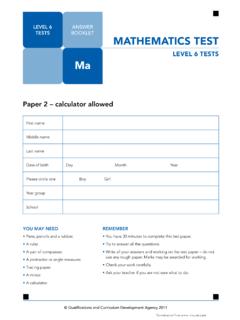Transcription of Year 4 Optional Feet First - SATs papers
1 year 4 Optional Feet First The Running Shoe A running shoe is a special type of trainer. It is designed to protect your feet from injuries and help to improve your performance. Running shoes support the foot in the typical running position when the toes are down and the heels are raised. A good running shoe has four important parts, each with its own job to do: As well as wearing the correct footwear, a runner has to train regularly in order to improve performance. Training for a race Warming up and cooling down It is important to warm-up and cool down every time you exercise. A warm-up gets your body ready for exercise. It helps your blood carry oxygen to your muscles so they are ready to work harder. When muscles are warm, they are more stretchy and tear less easily. You can warm-up by marching or jogging on the spot and doing stretching exercises.
2 A balanced routine should be developed which covers all the muscles used. You should warm-up for about five to ten minutes until you feel warm and are breathing a bit faster than normal. To cool down after exercising, do some slower movements until you are breathing normally again. Cooling down helps stop your muscles getting sore. Stretching after exercise can help you to become more supple. Training If you are in good shape and have no injuries, you will be able to race short distances often. It is very important to listen to your body and if you are over-racing slow down. The English Schools Athletic Association Award Scheme sets realistic targets for pupils of all abilities. Only short distances should be sprinted at maximum speed. year Distance 3 40 m 4 and 5 60 m 6 80 m Only year 5 and 6 children should attempt racing longer distances.
3 The recommended distance is 800 metres, which should be run and not sprinted. It is important to keep your body safe and comfortable when you are training. Do not train just after a meal or if you are unwell. Do not train so hard that your muscles hurt or you feel dizzy, sick or tired. Always drink plenty of water before and during exercise, especially in hot weather. This is to replace water you lose when you sweat. The benefits of exercise Running is only one way of exercising. Exercise keeps your body strong and fit. Fitness means you have enough energy to do all the things you want to do easily. Your body cannot store fitness so you need to exercise regularly to stay fit.












